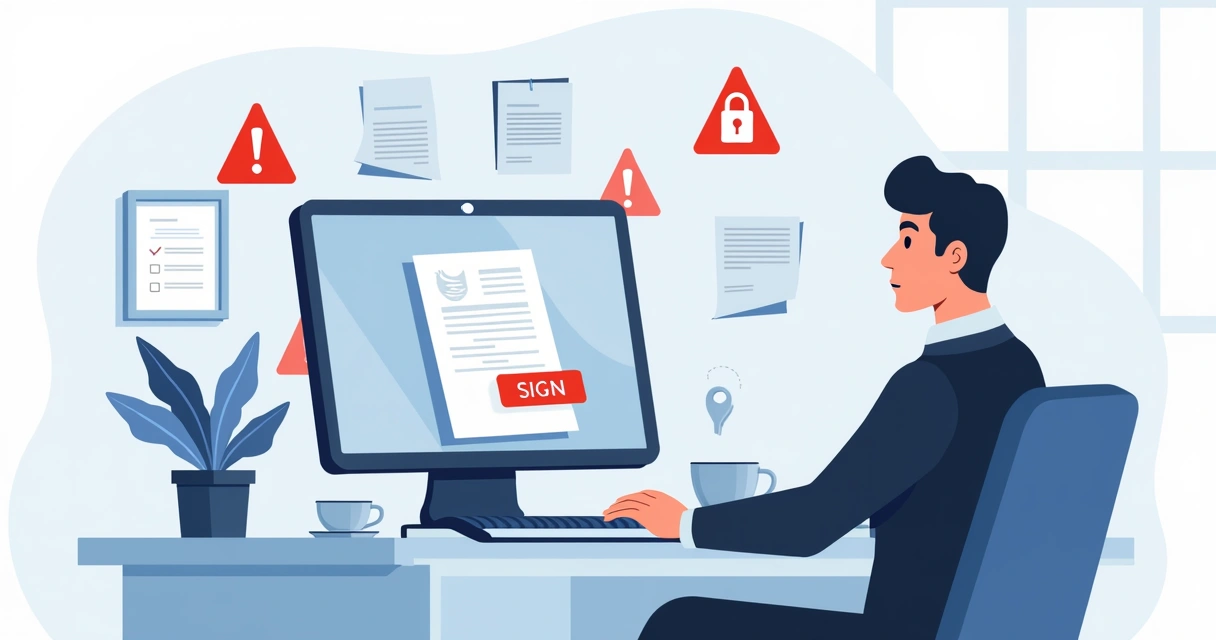Signing documents online seems simple. You upload, sign, send. Done. But some habits or shortcuts could put your contracts at risk, slow you down, or even land you into legal trouble. Over years of watching businesses and freelancers embrace digital signing platforms, I have seen the same mistakes crop up again and again. If you care about staying safe and saving time, it is time to stop making these eight common errors.
 Are you making these mistakes?
Are you making these mistakes?
- Trusting the wrong platform. Many people do not check if their signing solution is legitimate. That can mean exposure to fraud or your signed document being declared invalid.
Choose a provider that offers strong encryption, secure access, and is recognized by law.
- For example, not verifying the platform's legitimacy can bring financial losses and legal complications.
- Thinking every e-signature is legally binding. Not all online signatures are accepted in court. Laws such as eIDAS in the EU or the ESIGN Act in the US matter. A platform like CloudSign.ie follows required laws, but some competitors do not.
- As certain reports underline, platforms must comply with regional laws. Always check before committing.
- Ignoring security features. It is not just about passwords. Look for two-factor authentication, access logs, and tamper-evident seals. These help prevent fraud.
- Ignoring security protocols opens the door to data theft and document tampering.
- Forgetting to audit document access. Who can see or change the file? Not checking means others might tamper with contracts without you knowing.
- Assuming regulations never change. Laws do change sometimes, affecting what is valid or secure. Keep an eye out or use services that stay ahead. For example, the future of electronic signatures is more dynamic than most think.
- As experts warn, not following updates can put your agreements at risk.
- Failing to confirm who is signing. It seems simple, yet too often documents are sent to the wrong John Smith. Use platforms that double-check identity or integrate with CRM data. With CloudSign.ie, integrations like Slack and Google Drive help guarantee you reach the right person.
- Skipping policy or staff training. You might have a fancy system, but if your team does not know how to use it, someone will slip up. Small errors, like forgetting fields, mean big trouble.
- A good internal policy and workflow trainings save a lot of time and money in the long run.
- Sticking with outdated manual checks. If you are still manually scanning for risks or renewal deadlines, you are missing out. AI-driven platforms, like modern document management at CloudSign.ie, highlight risks and automate contract tracking for you.
If this sounds familiar, you are not alone. Some problems come from habit, some from moving too quickly. Tools evolve, laws shift, and even the best platforms (yes, even some of our competitors) may not cover everything you need. What sets CloudSign.ie apart is our focus on speed, legal compliance, security, and a transparent user experience. We back it all up with a free 14-day trial, no credit card required.
Staying current means more than just using new tech. It is about knowing what to avoid, what to double-check. For more practical tips for modern businesses, the digital transformation guide breaks down how smart tools change the way documents move and get signed.
Want regular updates and more in-depth advice? Check out the CloudSign.ie blog for the latest in e-signature best practices, compliance, and tools. If you are ready to protect your contracts and simplify your life, try CloudSign.ie and see how safe, fast, and easy signing documents online can be.
Frequently asked questions
What should I avoid when signing online?
Avoid using unverified platforms, skipping security features, ignoring updates in regulations, failing to confirm signer identity, and manual tracking of contracts. Mistakes like these can weaken your legal position. Always use trusted providers such as CloudSign.ie for safety and compliance.
Are online signatures legally binding?
Most are, as long as the platform follows the right laws like ESIGN or eIDAS. Not every platform meets these standards though. Services like CloudSign.ie follow legal requirements, keeping your documents valid in Ireland and internationally. More details can be found in our article on legal facts.
How can I check document security?
Look for encrypted file transfers, two-factor authentication, audit trails, and tamper-evident seals. Top platforms provide clear info on their security features. If these are missing, the provider probably is not safe.
What is the safest way to e-sign?
Use a reliable provider with recognized legal compliance, end-to-end encryption, and strong identity verification. AI-driven solutions add another layer of security by flagging risks before you sign.
Do all companies accept digital signatures?
Not every company or organization accepts digital signatures, but acceptance is growing fast, especially for B2B use. Well-known e-signature platforms like CloudSign.ie meet international legal standards, making signatures valid for most agreements. In rare cases, wet signatures might still be required, so always double-check the recipient's policy.
